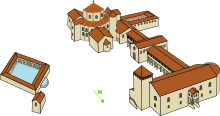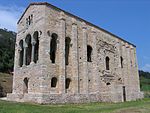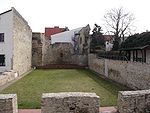Aula regia

Aula regia ( Latin for royal hall , synonymous for "royal castle, residence, pillared hall"), recently also called palace aula or Aula Palatina , is the name of the throne and reception rooms in the imperial palaces of ancient Roman architecture as well as in the royal palaces of the Middle Ages, hence also called the Palas Hall . The term was occasionally used as a synonym for the Falzes themselves.
Purpose and examples
Antiquity
The architectural model for the hall buildings of the medieval German and French Palatinate was the Constantine basilica in Trier , built under Emperor Constantine in the years 305-311, which in turn followed the Roman imperial palace on the Palatine (Rome) ; There are still the remains of his Aula regia in the Domus Flavia , the palace building completed in 92 AD by Emperor Domitian . The basilica in Trier has an outer length of 69.8 m (including the 12.4 m long apse) with a width of 27.2 m and in ancient times was about 30 m high. The (today brick-faced ) interior had high -quality wall cladding after construction: the nave and apse had floor and wall cladding made of inlaid marble slabs ( opus sectile ) up to the height of the uppermost window cornice, of which remnants and the holes of the iron brackets have been preserved. Stucco work followed up to the self-supporting ceiling. The Constantine Basilica, together with the Imperial Baths and the Trier Circus, formed a unit as a palace district, which consciously took up the relationship between Circus Maximus and Palatine , which was developed in Rome . The frequently used name Palastaula or Aula Palatina is more accurate, but has no evidence in classical Latin .
The monumental Aulae regiae served as the backdrop for the court ceremonies at audiences and receptions, in the Middle Ages also for the Imperial and Court Days as well as for the coronation meal , for wedding celebrations or other feasts. The ruler's throne is to be assumed in the apse . The early Christian basilicas followed the example of the Roman aulae regiae and placed the altar in the apse instead of the imperial throne.
middle Ages

Charlemagne created similar overall facilities as in Trier with his numerous palace buildings, above all the Aachen royal palace from around 780. Today the Aachen town hall stands on the foundation walls of the hall building of the Aachen royal palace . A surviving Visigoth Aula regia, built around 850 n. Chr., The later rededicated to the church hall building of Santa María del Naranco in Oviedo , which for the Asturian King I. Ramiro was built. In Germany the hall of the Kaiserpfalz Goslar of King Heinrich II from the 11th century is still standing . An auditorium regia is also proven as a pure hall building of Charlemagne in the Palatinate Paderborn ; From 1976, a reconstruction was carried out on the excavated foundation walls of what would later become the King's Hall from the 11th century. The royal hall of the Ingelheim imperial palace , also owned by Charlemagne, has been digitally reconstructed.
Constantine Basilica in Trier
Hall of the Kaiserpfalz Goslar
Remains of the Aula regia in the Ingelheim imperial palace
Reconstructed Aula regia in the Palatinate Paderborn
See also
- List of German royal palaces
- List of Franconian royal palaces in what is now France
- Parlement
- Regis Curia
Individual evidence
- ↑ Information according to Klaus-Peter Goethert, Marco Kiessel: Trier - Residenz in der Spätantike. In: Alexander Demandt, Josef Engemann (ed.): Konstantin der Große. Emperor Caesar Flavius Constantinus . Philipp von Zabern, Mainz 2007, ISBN 978-3-8053-3688-8 , pp. 304-311, here p. 307; after Hans-Peter Kuhnen: The palace auditorium (so-called basilica) of the late antique imperial palace. In: Hans-Peter Kuhnen (Ed.): The Roman Trier. 2001, pp. 135-142, 71.0 m × 32.6 m.
- ↑ Klaus-Peter Goethert and Marco Kiessel: Trier - Residence in late antiquity. In: Alexander Demandt, Josef Engemann (ed.): Konstantin der Große. Emperor Caesar Flavius Constantinus. Philipp von Zabern, Mainz 2007, pp. 307-311, here pp. 308f.
- ↑ Klaus-Peter Goethert, Marco Kiessel: Trier - Residence in late antiquity. In: Alexander Demandt, Josef Engemann (ed.): Konstantin der Große. Emperor Caesar Flavius Constantinus . Philipp von Zabern, Mainz 2007, ISBN 978-3-8053-3688-8 , pp. 304-311, here p. 307.
- ↑ Pevsner / Fleming / Honor, Lexikon der Weltarchitektur, 1984







